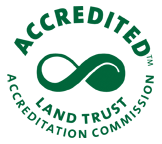 The New York State Conservation Easement Tax Credit (CETC) offers New York taxpayers whose land is restricted by a conservation easement an annual New York State income tax credit of up to 25% of the school district, county and town real estate taxes paid on the restricted land, up to an annual maximum of $5,000 per taxpayer. Unlike a tax deduction, which is an adjustment to taxable income, a tax credit offsets a taxpayer's tax liability on a dollarfordollar basis. The CETC is a REFUNDABLE income tax credit, which means that if a landowner's tax credit exceeds the amount he or she owes in state income taxes, the landowner gets a check for the difference. The CETC is available to individual landowners, estates, trusts, partnerships and certain corporations as long as the land they own is restricted by a perpetual and permanent conservation easement.
The New York State Conservation Easement Tax Credit (CETC) offers New York taxpayers whose land is restricted by a conservation easement an annual New York State income tax credit of up to 25% of the school district, county and town real estate taxes paid on the restricted land, up to an annual maximum of $5,000 per taxpayer. Unlike a tax deduction, which is an adjustment to taxable income, a tax credit offsets a taxpayer's tax liability on a dollarfordollar basis. The CETC is a REFUNDABLE income tax credit, which means that if a landowner's tax credit exceeds the amount he or she owes in state income taxes, the landowner gets a check for the difference. The CETC is available to individual landowners, estates, trusts, partnerships and certain corporations as long as the land they own is restricted by a perpetual and permanent conservation easement.
To qualify for this tax credit, the land must be located in New York State and the conservation easement must be held by a public or private conservation agency. The easement must serve to protect open space, biodiversity or scenic, natural, agricultural, watershed, or historic preservation resources by limiting or restricting development, management and/or use of the property.
They DO NOT APPLY to nonconservation easements, such as utility or transportation rights-of-way, etc. Nor do they apply to conservation easements that were created for the purpose of obtaining subdivision or building permits or to easements that were required as mitigation. You can claim a tax credit for each of the qualified easements on your land up to a total of $5,000 per year for all of them.
In order to claim a CETC, a landowner will need the following information:
- Location of the easementrestricted property (it should appear on the easement).
- Date the easement was conveyed.
- The county the easement was recorded in, the liber and page instrument number or control number.
- The DEC identification number assigned to the easement.
- County, town and school district property taxes paid on the easementrestricted land.
The landowner claims the CETC when filing his or her state income tax returns:
- Individual landowners file the new Form IT242 with their personal NYS income tax returns: IT201 for NY residents and IT203 for nonresidents and partyear residents.
- Estates and trusts file Form IT242 with Form IT205 to show each beneficiary's share of the credit.
- Partnerships file Form IT242 with Form IT204, showing the total amount of the credit.
- Corporations file Form CT242 with Form CT3 or CT3A.



